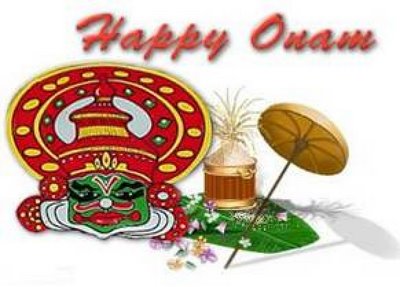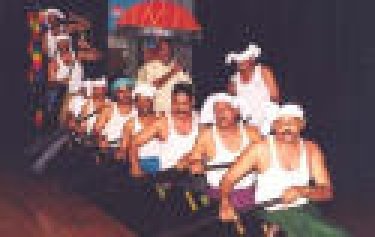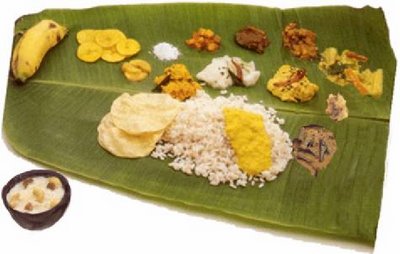
Thank you Satish and Vimla in Kottayam for sharing this with me. Copyright acknowledged for who created this.
Hi !
After sending an earlier Onam greeting, I found that a more informative Onam message would be more useful to keep up the good old traditions (lest some of us forget what its all about) and I am forwarding herewith the greeting that I recieved from a friend! Share it with your friends and keep the good times in sight!
WE WISH YOU ALL A VERY HAPPY ONAM, OUR NATIONAL FESTIVAL
Satish & Vimla Abraham.
Thiru Onam is celebrated in the second half of August (the Chingam month of Kollam Era) when the August monsoon rains come to an end and the summer heat gives way to the pleasant warmth of the Kerala autumn. Anthropologists see in Onam a great fertility rite, the ceremony of Thanksgiving for a plentiful harvest. For Keralites Onam is the celebration of the return of Mahabali, their once beloved king.
The Origin of Onam
Onam or Thiruonam originated as a joyous annual reminiscence of the golden rule of King Mahabali, a mythical king, who ruled Kerala a very long time ago. It recalls the sacrifice of the great king, his true devotion to God, his human pride and his ultimate redemption. This king once ruled over the Keralites during the Golden Age before caste existed, "when all men were equal, when no one was poor, when there was neither theft nor dread of thieves" (Maveli natu vanitum kalam... Manusharellam onnu pole ... ).
The complete folk-song is given in its English version.
When Maveli, our King, rules the land,
All the people form one casteless race.
And people live jo yful and merry;
They are free from all harm.
There is neither theft nor deceit,
And no one is false in speech either.
Measures and weights are right;
No one cheats or wrongs the neighbor.
When Maveli, our King, rules the land,
All the people form one casteless race.
The Legend
Facts and fables blend as Kerala celebrates this royal return, year after year with the festivities of Onam. Legend has it that the gods plotted against Mahabali to end his reign. For this they sent Lord Vishnu to earth in the form of a dwarf Brahmin. But before being trampled down to the netherworld, Vishnu granted the king's sole wish: To visit his land and people once every year.
The complete story is given below in this message
The Custom
Pookalam
A flower carpet called 'Pookalam' is laid in front of every house to welcome the advent of the vanquished king, and earthen mounds representing Mahabali and Vishnu are placed in the dung-plastered courtyards. Traditional rituals are performed followed by a lavish feast called 'Sadhya'. Onam also means new clothes for the whole family, sumptuous home-cooked delicacies on plantain leaf and the lingering aroma of the sweet Payasam.
The recipes of the onam special delicacies are available in this message
Kaikottikali
Onam is in the air. Its time to revive our rich folk arts when women come out with their dances, especially kaikottikalli. This is the period from "atham" to Onam when the Malayali celebrates a bumper harvest and is in a festive mood.
The women-folk neatly decked up in mundu-veshti and ornamental flowers in their hair decorate their frontyard and "nadumittam" with flowers and light a lamp near an idol of Ganapathy in a gesture to overcome all hurdles in their path to prosperity.
The simple rythmic group dance which involves clapping each other's palms while encircling the pookalam is what's known as kaikottikali, the essence of Onam.
Women, young and old, take part in the folk dance which signifies joy, happines and festivity. Though kaikottikali is neither a ritual form of dance or stage art, it derives its "ragachaya" from kathakali and the songs are based on episodes and legends like Krishnaleela, Shakunthalam, Kuchelavritham and Dhruvacharithram. Emphasis is given on rythmic movements than on mudra. The uniqueness of kaikottikali lies in the fact that the songs are sung by the participants themselves and the dance involves just simple steps in unison.
The most common ragams found in the kaikottikali songs include the Hussaini, Bhairavi and Kamboji and on several occasions the song deviate from puranic tales to folk stories.
Songs are also sung in praise of Saraswati, Ganapathy and Krishna which is considered to be very auspicious. Sadya over, on Onam day, women dance away to glory till the euphoria wanes.
The Spectacle
Spectacular parades of caparisoned elephants, fireworks and the famous Kathakali dance are traditionally associated with Onam. It's also the season of many cultural and sport events and carnivals. All this makes Onam-time a perfect period to visit this coastal state, touted as "Gods Own Country". No wonder the Government of Kerala has declared this time every year as Tourism Week.
The Grand Boat Race
One of the main attractions of Onam, is the 'Vallamkali' or boat races of Karuvatta, Payippad, Aranmula and Kottayam. Hundreds of oarsmen row traditional boats to the rhythm of drums and cymbals. These long graceful Snake Boats called 'Chundans' are named after their exceedingly long hulls and high sterns that resemble the raised hood of a cobra.
Then there are 'Odis', the small and swift raiding crafts adorned with gold tasseled silk umbrellas, the 'Churulans' with their elaborately curled prows and sterns, and the 'Veppus', a kind of cook-boat. This traditional village rivalry on watercrafts reminds one of ancient naval warfare.
Thousands throng the banks to cheer and watch the breathtaking show of muscle power, rowing skills and rapid rhythm. These boats - all pitted against their own kind - rip through the backwaters of Kerala in a tussle of speed.
Onam is for All
Although this festival has its origin in Hindu mythology, Onam is for all people of all class and creed. Hindus, Muslims and Christians, the wealthy and the downtrodden, all celebrate Onam with equal fervor. The secular character of Onam is peculiar to this land where unity had always coexisted with diversity, especially during festivals, when people come together to celebrate life's unlimited joys.
A long long time ago, an Asura (demon) king called Mahabali ruled Kerala. He was a wise, benevolent and judicious ruler and beloved of his subjects. Soon his fame as an able king began to spread far and wide, but when he extended his rule to the heavens and the netherworld, the gods felt challenged and began to fear his growing powers. Presuming that he might become over-powerful, Aditi, the mother of Devas pleaded with Lord Vishnu to curtail Mahabali's powers.
Vishnu transformed himself into a dwarf called Vamana and approached Mahabali while he was performing a yajna and asked for alms. Pleased with the dwarf brahmin's wisdom, Mahabali granted him a wish. The Emperor's preceptor, Sukracharya warned him against making the gift, for he realized that the seeker was no ordinary person. But the Emperor's kingly ego was boosted to think that God had asked him for a favor. So he firmly declared that there is no greater sin than going back on one's promise. He kept his word.
The Vamana asked for a simple gift "three paces of land" and the king agreed to it. Vishnu in the guise of Vamana then increased his stature and with the first step covered the sky, blotting out the stars, and with the second, straddled the netherworld. Realising that Vamana's third step will destroy the earth, Mahabali offered his head as the last step.
Vishnu's fatal third step pushed him to the netherworld, but before banishing him to the underworld Vishnu granted him a boon. Since he was attached to his kingdom and his people, he was allowed to return once a year from exile. Onam is the celebration that marks the homecoming of King Mahabali. It is the day when a grateful Kerala pays a glorious tribute to the memory of this benign king who gave his all for his subjects.
Another Legend
Another legend has it that King Mahabali was a devout worshipper of Lord Vishnu. He was sincere, honest, just and a good ruler. But he had one weakness ego. And to eradicate his pride and redeem his beloved devotee of this one sin, Vishnu came to earth in the form of a dwarf Brahmin named Vamana.
The king in his pride asked the Brahmin what he wanted for he could give anything. Vamana asked for three paces of land and the king agreed. To humble him Vishnu, as Vamana showed Mahabali that he is just a puny creature in front of God's universal stature.
Mahabali, who was a man of principles, realized God's purpose and offered his head for Vamana's footstep, as he was sent to another world. This fatal step proved a blessing in disguise for the good king the foot salvaged and released him from the recurrent cycle of birth and death. That is why Onam is celebrated by wearing new clothes and resolving to lead a new life of truth, piety, love, and humility.
The Feast
'Onasadhya' is the grand feast served during the celebration of Onam in Kerala.
It is served on Banana leaves. There is a way of placing the leaf and an order of serving the dishes. The picture given below shows the serving order beginning from the left with 'Upperies'.
PARIPPU CURRY
SAMBAR
AVIAL
KALAN
OLAN
THORAN
PULIINJI
INJITHAIR
PINEAPPLE PACHHADY
ERISSERY
KOOTUCURRY
NARANGA PICKLE
MANGA CURRY
BANANA CHIPS
SARKARAPURATTY
PAYASAM
PRATHAMAN
LADY'S FINGER KICHADI
Rice is the main course. With rice, various kinds of dishes are served... curries, 'upperies' (things fried in oil), 'pappadams' (round crisp flour paste cakes of peculiar make), 'achchars' (pickles of various kinds), 'payasams' and 'prathamans' (Desserts). Fruits are also served, mainly plantain.
PARIPPU CURRY
Ingredients :
1.
Lentils (green gram dal) - 1 cup
Water - 3 cups
Turmeric powder - 1/2 tsp
2.
Salt - to taste
Ghee (Clarified butter) - 2tsp
Method of Preparation :
Lightly fry the lentils in a pan. Boil 3 cups water and add the washed lentils and turmeric powder. When it boils, lower the flame. When the lentils are cooked well, add salt to taste and ghee. Mix well and remove from fire.
SAMBAR
The chief ingredients are dhal and vegetables such as, brinjal, drum-stick, bitter gourd (pavakkai), ladies finger etc. It is a favorite dish in South India.
Ingredients - Serves 10
1.
Bitter gourd - 1/2
Brinjal (egg plant) - 1 no
Drum Stick - 1no
Ladies fingers - 4 nos
Red chillies - 4 nos (split into 2)
2.
Sambar dal (Red gram dal) - 1 cup
Turmeric powder - 1/2 tsp
Curry leaves - 1 sprig
Water - 3 cups
3.
Tamarind - size of a golf ball
Water - 1 cup
Red chilli powder - 1 tsp
Salt - to taste
Curry leaves - 1 sprig
Asafoetida powder - 1/4 tsp
Grated molasses - 1/4 tsp
Coconut oil - 2 tbs
White gram dal - 1/4 tsp
Fenugreek - 1/4 tsp
Dried chilli - 4 nos
Coconut oil - 1/2 tsp
4.
Dried coriander seeds - 2 tbs
5.
Coconut oil - 2 tsp
Mustard - 1 tsp
Dried chillies split into 2 - 2 nos
6.
Coriander leaves - few
Method of Preparation :
Clean the vegetables and slice into long pieces.
Wash the dal. Boil 3 cups of water and cook dal in it. Add turmeric powder and curry leaves into the dal. Keep it aside.
Fry the 4th ingredients in 1/2 tsp of coconut oil. Grind it to a smooth paste and keep aside.
Mash the tamarind in 1 cup water and strain. Boil the tamarind water with red chilli powder, salt, curry leaves, asafoetida and molasses. When it boils, add 2 tbs of coconut oil. Add the vegetables except the ladies finger into it. Cook till done and add the prepared dal into it. Bring to a boil and add the ladies finger and the ground masalas. Remove from fire after boiling.
Season with mustard seeds and dried chillies. Sprinkle the Sambar with chopped coriander leaves.
Note : Various vegetables like potato, carrot, radish, tomato etc can also be added to the sambar.
AVIAL
This is a semi-dry preparation which is a mixture of all sorts of vegetables.
Ingredients (Serves 10 )
1.
Yam sliced thinly into 1 1/2" length pieces - 1 cup
Cucumber sliced lengthy into 1 1/2" thick pieces - 1 cup
Snake gourd sliced into 1 1/2" length pieces - 1 cup
Carrot sliced into into 1 1/2" length pieces - 1/4 cup
Long runner-beans sliced into 11/2" length pieces - 1/2 cup
Drumstick cut into 2" length pieces - 2 nos
2.
Raw bananas sliced into 1 1/2" length pieces - 1 no
Mango pieces - for sour taste
3.
Turmeric powder - 1/2 tsp
Salt - to taste
4.
Grated coconut - 1/2 quantity
Green chillies - 5 nos
Cumin seeds - 1/2 tsp
5.
Curry leaves - 2 sprigs
Coconut oil - 3 tbs
Method of Preparation :
Coarsely grind the coconut, green chillies and cumin seeds. Keep it aside.
Clean the vegetables. Heat 2 tbs of coconut oil in a thick bottom vessel. Add the vegetables and cook on a low flame. Do not add water. When it is done, add turmeric powder, salt and mix it well. Remove the vegetables from the middle and put sliced bananas and mango pieces and cover it with the other vegetables. When steam emerges, add the coconut paste and stir well. Remove from fire. Mix the remaining coconut oil and curry leaves in the avial.
KALAN
It is a preparation of buttermilk with thick gravy. Sliced plantains known as nenthra-kaya and yams (chena) are boiled in water with salt and chillies. Buttermilk mixed with ground coconut pulp is poured in proper time and the preparation is flavored by the addition of mustard, fried in coconut oil.
Ingredients (Serves 10 )
1.
Yam sliced into small pieces - 100 gm
Small raw banana 1 no
Green chillies (slit the edge) - 3 nos
2.
Pepper powder - 1 tsp
Water - 1 cup
Turmeric powder - 1/4 tsp
Salt - to taste
3.
Ghee (clarified butter) - 1 tsp
Curry leaves - 1 sprig
4.
Mashed yogurt (without water) - 1/2 litre
5.
Grated coconut - 1/2 quantity
Cumin seeds - 1/2 tsp
6.
Fried and powdered fenugreek - 1/2 tsp
7.
Ghee (clarified butter) - 3 tsp
Dried chilli (split into 2) - 2 nos
Mustard - 1 tsp
Method of Preparation:
Remove the skin of the plantain and slice it into small pieces.
Grind the coconut and cumin to a smooth paste without adding water. Keep it aside.
Dissolve the pepper powder in 1/2cup of water and strain it through a clean cloth. Cook the vegetables in this water. Add the turmeric powder and salt. Stir well. When the water dries, add 1tsp ghee. Pour the yogurt and mix well. Lower the flame. When the curd boils and becomes dry and thick, add the grinded coconut mixture and fenugreek powder into it. Stir well. Brings to a boil and remove from fire. Season with mustard, dried chillies and curry leaves.
OLAN
Ingredients - Serves 10
1.
Ash gourd - 100 gm
Pumpkin - 100 gm
Green chillies - 4 nos (split the edge)
Red gram dal - 1 tbs (soaked in the water for about 6 hours)
2.
Grated coconut - 1/2 quantity
(Squeeze out 1/4 cup of the milk from the coconut without adding water. Take one more cup of milk from the coconut)
3.
Salt - to taste
4.
Coconut oil - 1 tbs
Curry leaves - 1 sprig
Method of Preparation :
Remove the covering of the ash gourd and pumpkin and cut them into small pieces. Cook the vegetables and red gram dal in water. Add enough salt and the green chillies. When it is done, add 1 cup of coconut milk and boil. When it thickens well, add 1/4 cup coconut milk. Bring to a boil and remove from the fire. Add 1 tbs coconut oil and the curry leaves and mix well.
THORAN
Ingredients :
1.
Cabbage, long runner-beans or any other vegetable, cut in to small pieces - 500 gm
2.
Coconut oil - 2 tsp
Mustard seeds - 1/2 tsp
Black gram - 1 tsp
Dried red Chilly (cut into 2-3 pieces) - 4 nos
3.
Salt - to taste
Turmeric powder - 1/4 tsp
Red chilly powder - 1/4 tsp
4.
Coconut - 1 cup
Cumin Seeds - 1/4 tsp
Curry leaves -2 sprigs
Garlic cloves - 2 nos
Method of Preparation :
Crush the coconut, cumin seeds, curry leaves and garlic. Put the vegetables in a pan and boil with salt and chillies. Heat the oil in a pan and saut�
2nd ingredients. Add the tumeric and chilly powder, boiled vegetables and crushed ingredients. Mix well and serve hot.
PULIINJI
This is a preparation where ginger is the main ingredient.
Ingredients
1.
Ginger - 25 gm
Green Chillies - 4 nos.
2.
Coconut oil - 1 tsp
Dried red chilly - 1 no. cut in to 4 pieces
Mustard seeds - 1/2 tsp
3.
Tamarind - size of a lemon
Water - 2 cups
4.
Turmeric powder - 1/4 tsp
Chilly Powder - 1/4 tsp
Asafoetida powder - 1/4 tsp
Jaggery (grated) - 25 gm
Curry leaves - 1 sprigs
Fenugreek seeds -1 pinch
Method of preparation:
Peel the ginger and cut into very small pieces. Cut the green chillies also into small pieces. Heat oil and sauté the 2nd ingredients for a minute. Add ginger and green chilly pieces and fry well and keep it aside. Put tamarind in two cups of water, squeeze well and take the liquid. Keep this liquid on fire adding the 4th ingredients. Boil till the solution becomes thick. Add the fried ginger and chilly pieces, boil once more and remove from fire.
INJITHAIR
Ingredients
Nicely chopped ginger - 4 spoons
Curd - 6 spoons
Salt - as required
Method of preparation
Mix all the ingredients and stir well. The injithair is ready.
PINEAPPLE PACHHADY
Ingredients :
1.
Ripe pineapple cut into 1/2" square pieces - 2 cups
Turmeric powder - 1/2 tsp
Salt - to taste
2.
Grated coconut - 1 cup
Dried red chilli - 1
3.
Coconut oil - 2 dsp
Mustard seeds - 1/2 tsp
Dried red chillies - 3 (cut into 6 pieces)
Curry leaves - 1 sprig
4.
Crushed mustard - 1 tsp
Method of Preparation :
Boil pineapple, with turmeric and salt in 1/2cup water. Grind coconut with dried chilli to a fine paste.
Heat the oil and season with mustard seeds. Saute the coconut paste and add the curry leaves and dried red chillies. When it is done, add the boiled pineapple pieces. The gravy should be thick and the cover the pineapple pieces. Add the crushed mustard just before removing the pachhady from fire.
have a GREAT ONAM!












No comments:
Post a Comment